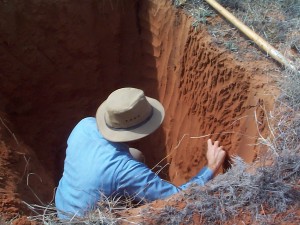Soils are of high interest to the WIPP EM because aerosol releases of contaminants would eventually be deposited in surface soils, which then can serve as a source for continuing contaminant exposure and uptake via direct contact, food chain pathways, and re-suspension. From this perspective, soil is an integrating medium of primary concern in predictive ecosystem and contaminant transport modeling, that requires good information about the dispersion of analytes of concern across the landscape.
The soil sampling design for the WIPP EM baseline and monitoring studies is organized to address analyte variability on three spatial scales. First, soil sampling is conducted within a 166 km2 area centered on the WIPP operations facility, and at a comparable area encompassing the Cactus Flats aerosol sampling station. Within each of these two areas, samples are collected at 16 locations positioned in concentric rectangular grids as shown in the figure.
For baseline studies, at each of the 16 locations in each area, samples were collected at three randomly selected sites within 25-m of the location’s reference point. Individual sampling sites are selected on the basis of relatively flat topography and minimum surface erosion or disturbance due to human or livestock activity. The resulting data provided for estimation of variability at the small-scale (between samples within a .0025 km2 area), medium-scale (among locations within each 166 km2 area), and large-scale (between the two sampling areas located approximately 19 km apart).
During baseline studies, samples for pilot projects were collected at various times in 1996 and 1997 using this spatial design. In 1998 and 1999, the full suite of 96 samples were collected. In 2000 and subsequent years, one sample at each of the 16 locations in each area (32 total) are being collected annually. The limitation of soil sampling to one period annually is based on the assumption that any input of contaminants to surface soils from WIPP releases would occur via aerosol deposition, and since aerosol sampling is conducted continuously, more frequent soil sampling is not warranted unless there was evidence of a contaminant increase in aerosols.





